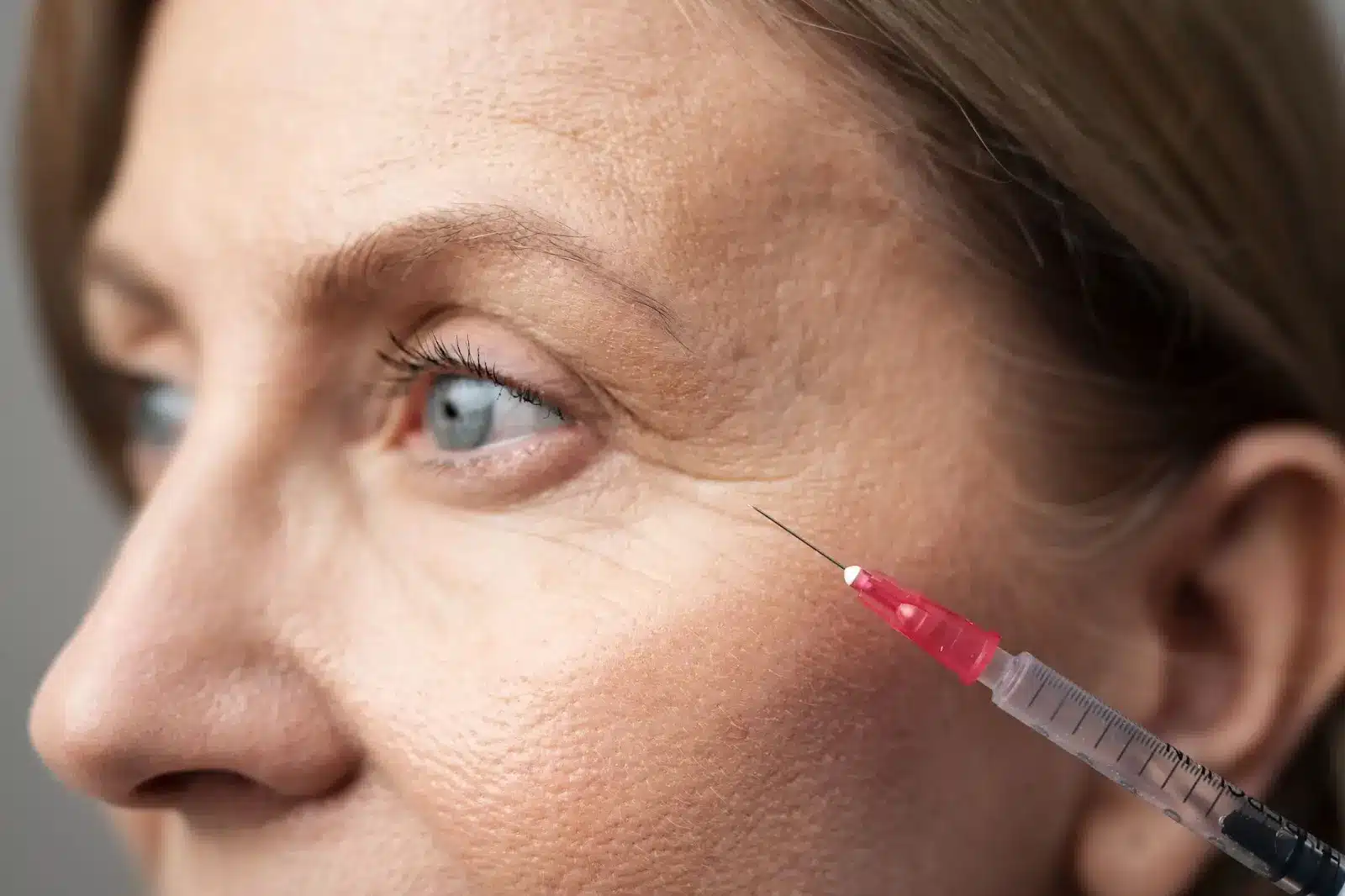
Facial injections using botulinum toxin have become a cornerstone of modern cosmetic treatments, offering a minimally invasive solution for facial rejuvenation. In 2024 alone, over 9.8 million botulinum toxin injections were administered in the United States, reflecting the growing demand for wrinkle-reducing procedures.
Among the many botulinum toxin options available, Botulax and Meditoxin have emerged as popular choices in aesthetic medicine. Both are known for their ability to smooth fine lines and relax facial muscles, but they differ in key aspects such as formulation, performance, and market reputation.
This article will dive into a detailed comparison of Botulax vs Meditoxin, covering their effectiveness, safety, longevity, and overall user experience.
Key Takeaways
- South Korean manufacturers developed both Botulax and Meditoxin, two botulinum toxin type A products, each with distinct formulations and unique advantages.
- Meditoxin comes in a pre-mixed solution, eliminating the need for reconstitution, making it more convenient for high-volume clinics and reducing handling errors.
- Botulax is a freeze-dried powder that requires reconstitution with saline, a process that can introduce variability in preparation.
- Meditoxin offers a faster onset of action, typically showing results within 3-5 days, compared to Botulax, which takes 4-7 days to show noticeable effects.
- In terms of duration, Botulax lasts 6–9 months, while Meditoxin typically lasts 4–6 months, with some users reporting effects that last longer.
- Manufacturers formulated Meditoxin albumin-free, which may reduce the risk of immunogenicity and neutralizing antibody formation compared to other botulinum toxins.
- Botulax is more affordable and widely available in international markets, making it a more budget-friendly option, especially in emerging markets.
- Both products are effective in reducing wrinkles, with Meditoxin offering greater precision due to its lower diffusion coefficient.
- Clinicians often choose Botulax for larger treatment areas, while Meditoxin performs better in targeted applications that require greater control over diffusion.
- The choice between Botulax and Meditoxin depends on factors like treatment speed, duration, cost, and clinician preference for handling and dosing.
About: Doctor Medica is your trusted supplier of top-quality dermal fillers, viscosupplements, and more for your medical practice. We offer genuine products from leading brands at the lowest prices in the market. If you’re looking to order Meditoxin online for your practice, contact Doctor Medica today.
Product Overview & Manufacturer Credentials

Understanding the origins and formulation of botulinum toxin products is essential for practitioners aiming to make informed decisions about treatment options. Although both Botulax and Meditoxin are botulinum toxin type A injectables from South Korea, they differ significantly in manufacturer practices, formulation components, and market presence. These are factors that can impact clinical handling, performance, and patient outcomes.
Botulax
Manufactured by Hugel Inc. since 2010, Botulax has gained significant traction both domestically and internationally, particularly in regions like the UAE. Providers commonly use Botulax in cosmetic and therapeutic treatments for wrinkle reduction and muscle disorder management, due to its affordability and consistent results.
Its freeze-dried powder form requires reconstitution with saline before use, a step that could introduce potential variability in preparation.
Meditoxin
Medytox developed Meditoxin, which is also marketed as Neuronox in specific markets. It uses a gelatin-based buffer, which some studies suggest may reduce the risk of allergic reactions compared to other botulinum toxins. The product comes in a pre-mixed form, offering more convenience and consistent potency.
As the Meditoxin vs Nabota comparison often shows, Meditoxin appeals for its precision and predictability in clinical settings, especially for practitioners focusing on areas requiring delicate handling.
Pharmacological Profile: Diffusion, Molecular Structure & Complexing Proteins

Understanding the pharmacological properties of Botulax and Meditoxin is crucial for choosing the appropriate product for specific clinical needs. Both are botulinum toxin type A products with the same core neurotoxin size (900 kDa), but their formulations lead to variations in diffusion behavior, potency, and overall performance.
| Feature | Botulax | Meditoxin |
| Neurotoxin protein/vial | ~844 pg per vial, with approximately 103% inactive neurotoxin content | ~575 pg per vial, with around 38% inactive neurotoxin—more efficient content |
| Specific potency | Approximately 0.118 U/pg | Approximately 0.174 U/pg—more active toxin per picogram |
| Complexing proteins | Includes accessory proteins for stabilization | Gelatin-buffered and albumin-free, reducing the risk of allergic reaction |
| Diffusion | Standard diffusion is suitable for broader treatment areas | Slightly lower diffusion (~0.23 cm²/day), allowing greater injection precision |
While Botulax is reliable for general applications with broader diffusion, Meditoxin offers more targeted precision with a lower diffusion coefficient, making it suitable for sensitive or high-precision areas, such as the area around the eyes.
Manufacturers designed Meditoxin to be more efficient in content, delivering a higher active neurotoxin per picogram, which can produce faster effects with a minimal protein load.
Clinical Efficacy, Safety & Patient Outcomes
While both Botulax and Meditoxin effectively reduce dynamic wrinkles and relax facial muscles, clinicians often prefer Meditoxin for its faster onset and longer-lasting effects in some cases. According to patient and practitioner feedback, Meditoxin may show visible results within 3–5 days, with its full effects typically visible by 7–10 days. In contrast, Botulax normally shows effects between 4 and 7 days after injection.
The duration of effect is another critical difference. Botulax can last between 6–9 months, particularly in deeper muscle groups or when injected in higher doses. Although Meditoxin’s typical duration ranges from 4–6 months, some patients report effects lasting up to 8 months, depending on the treatment area and individual response.
Side effects for both toxins are relatively minimal, with mild bruising, swelling, or temporary eyelid ptosis being the most common. Serious side effects are rare. One key difference is that Meditoxin, with its gelatin-buffered, albumin-free formula, may carry a lower risk of immunogenicity compared to other botulinum toxin formulations that include human serum albumin. This reduces the risk of neutralizing antibodies forming after repeated treatments, which can compromise long-term effectiveness.
Practical Considerations: Reconstitution, Handling & Unit Conversion
The handling and storage of Botulax and Meditoxin require different protocols, and understanding these practical aspects is vital for both clinicians and patients.
Botulax is supplied as a freeze-dried powder that requires reconstitution with preservative-free saline before use. While this is standard practice for many botulinum toxin formulations, it introduces the potential for dilution errors or foaming if not done carefully.
Meditoxin is a pre-mixed solution, making it easier to handle. It does not require reconstitution and is ready for immediate injection, reducing preparation time and the potential for handling errors. Additionally, Meditoxin has a higher potency per unit, meaning it may require fewer units for the same effect as Botulax.
Clinicians must store both products in a cold chain between 2°C and 8°C to maintain stability and potency. After reconstitution, both should ideally be used within 24 hours, although Meditoxin offers easier storage due to its pre-mixed form.
Pricing and Availability
Meditoxin is generally considered more cost-effective, particularly in Asian markets where it has a strong presence. It offers an attractive option for high-volume clinics or those seeking a budget-friendly solution without compromising on efficacy. Botulax, on the other hand, is more widely available internationally, especially in emerging markets like the UAE.
Although both products are typically priced similarly, Meditoxin may offer better affordability in high-volume practices, thanks to its ease of use and shorter preparation time.
Conclusion
Choosing between Botulax and Meditoxin depends on several factors, including treatment speed, duration, precision, and budget. Meditoxin excels in providing faster onset, longer-lasting effects, and ease of use due to its pre-mixed solution. This makes it a strong choice for practices aiming for efficiency and precision in treatment.
However, Botulax offers wider availability, cost-effectiveness, and familiarity for those accustomed to the traditional freeze-dried format. It’s an excellent choice for clinics with a more customizable approach to dosing and treatment planning.
Ultimately, the decision comes down to patient priorities and clinician preference based on experience with the products.
FAQs
1. How fast does Meditoxin work compared to Botox/Botulax?
Meditoxin typically shows effects within 3–5 days, versus Botox/Botulax taking 4–7 days.
2. Can I expect fewer side effects with Meditoxin?
Its albumin-free, lower protein profile suggests reduced immunogenicity; side effects are generally mild with both products.
3. Do Meditoxin units convert directly to Botulax units?
Clinicians often use a 1:1 equivalence, but slight adjustments based on response and muscle mass are standard.
4. Which lasts longer, Meditoxin or Botulax?
Meditoxin generally lasts 4–6 months, while Botulax can last up to 9 months.
References
American Society of Plastic Surgeons. 2024 Plastic Surgery Statistics Report. https://www.plasticsurgery.org/documents/news/statistics/2024/plastic-surgery-statistics-report-2024.pdf
Frevert J, Ahn KY, Park MY, Sunga O. Comparison of botulinum neurotoxin type A formulations in Asia. Clin Cosmet Investig Dermatol. 2018;11:327-331. Published 2018 Jul 5. doi:10.2147/CCID.S160723
Related Articles
Joanna Carr
Revanesse Vs Restylane – Which Is the Better Filler?
Revanesse and Restylane are both popular hyaluronic acid-based fillers that offer natural-looking results but differ in their formulations and uses.
Joanna Carr
How to Reduce Discomfort and Bruising from Filler Injections
Interested to learn more about How to Reduce Discomfort and Bruising from Filler Injections? Browse Doctor Medica's comprehensive listing of blog post...
Joanna Carr
Controversy Surrounds New Scrotox Trend
Interested in learning more about Controversy Surrounding New Scrotox Trend? Browse Doctor Medica's comprehensive archive of blog posts.


